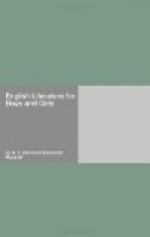To trace the English drama from its beginnings we must go a long way back from the reigns of Henry VII and of Henry VIII, down to which the life of Dunbar has brought us. We must go back to the days when the priests were the only learned people in the land, when the monasteries were the only schools.
If we would picture to ourselves what these first English plays were like, we must not think of a brilliantly lighted theater pranked out and fine with red and gold and white such as we know. We must think rather of some dim old church. Stately pillars rise around us, and the outline of the arches is lost in the high twilight of the roof. Behind the quaintly dressed players gleams the great crucifix with its strange, sad figure and outstretched arms which, under the flickering light of the high altar candles, seems to stir to life. And beyond the circle of light, in the soft darkness of the nave, the silent people kneel or stand to watch.
It was in such solemn surroundings that our first plays were played. And the stories that were acted were Bible stories. There was no thought of irreverence in such acting. On the contrary, these plays were performed “to exort the mindes of common people to good devotion and holesome doctrine.”
You remember when Caedmon sang, he made his songs of the stories of Genesis and Exodus. And in this way, in those bookless days, the people were taught the Bible stories. But you know that what we learn by our ears is much harder to remember than what we learn by our eyes. If we are only told a thing we may easily forget it. But if we have seen it, or seen a picture of it, we remember it much more easily. In those far-off days, however, there were as few pictures as there were books in England. And so the priests and monks fell upon the plan of acting the Bible stories and the stories of the saints, so that the people might see and better understand.
These plays which the monks made were called Mystery or Miracle plays. I cannot tell you the exact date of our first Miracle plays, but the earliest that we know of certainly was acted at the end of the eleventh or beginning of the twelfth century. It is not unreasonable to suppose, however, that there had been still earlier plays of which we know nothing. For the Miracle plays did not spring all at once to life, they began gradually, and the beginnings can be traced as far back as the ninth century. In an old book of rules for Winchester Cathedral, written about 959, there are directions given for showing the death and resurrection of Christ in dumb show chiefly, with just a few Latin sentences to explain it. By degrees these plays grew longer and fuller, until in them the whole story of man from the Creation to the Day of Judgment was acted in what was called a cycle or circle of short acts or plays.
But although these plays were looked upon as an act of religion, they were not all solemn. At times, above the grave tones of the monks or the solemn chanting of the choir, laughter rang out. For some of the characters were meant to be funny, and the watching crowd knew and greeted them as such even before they spoke, just as we know and greet the jester or the clown.




